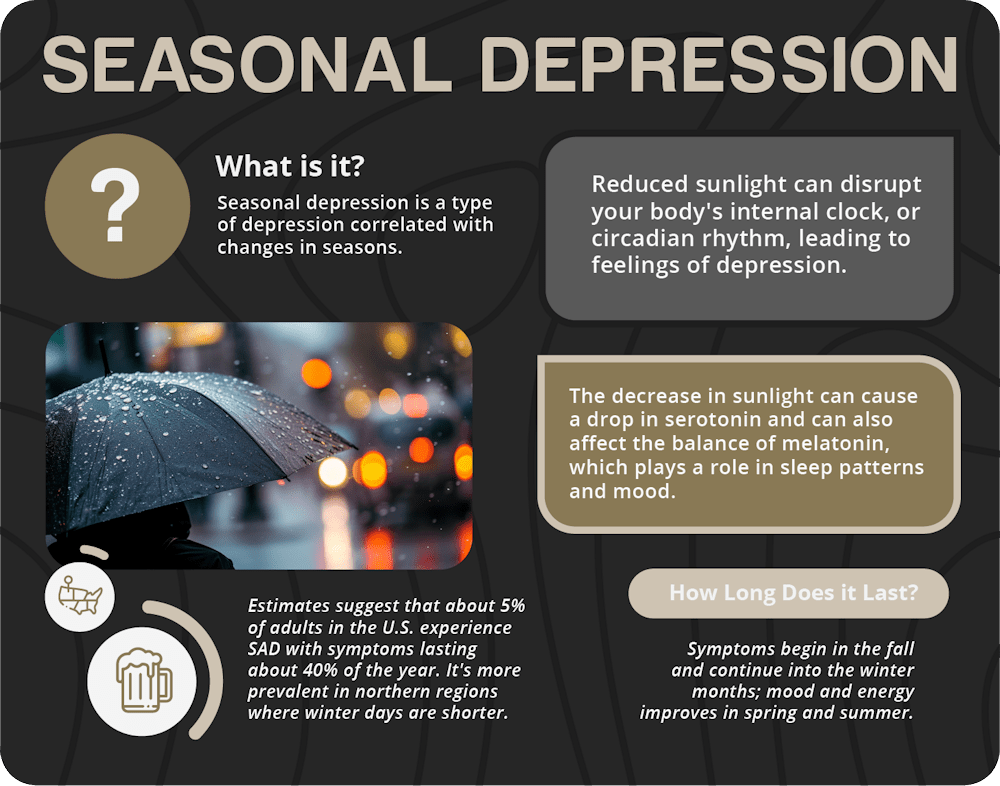A specific type of depression is experienced by some people during the winter months called Seasonal Affective Disorder (SAD). Cold weather isn’t the only thing that affects people’s moods; diminishing sunlight plays an equally important role. With daylight hours decreasing, the lack of natural light can disrupt the body’s internal clock and lead to feelings of sadness and lethargy. When it comes to addressing and managing SAD, it is important to understand the effect of reduced sunlight on mental well-being.
December is designated as Seasonal Affective Disorder Awareness Month to shine a light on the challenges many people face during this season. With reduced daylight impacting mood and well-being, December serves as a pivotal time to raise awareness about Seasonal Affective Disorder (SAD) and its effects on people.
Acknowledging the prevalence of SAD during the holiday season, the aim is to foster understanding and encourage support for those navigating the emotional complexities associated with this condition. Given that December is Seasonal Affective Disorder Awareness Month, it is an opportunity to educate and promote empathy, encouraging people to feel understood and supported during a season that can be particularly challenging for mental health. Seasonal Affective Disorder can make it hard to navigate the changes in the seasons and how they affect your well-being. At Westwind Recovery®, we provide support and resources to help you cope with the challenges and build a sense of belonging and empathy with others who are going through the same thing.
What Causes SAD?
Seasonal Affective Disorder (SAD) finds its roots in the changing seasons, notably during winter when daylight diminishes. People’s internal body clocks and serotonin production are disrupted as a result of the reduction in sunlight, resulting in symptoms like fatigue and persistent low mood. Understanding these environmental factors impacting mood is vital for people affected by SAD and those supporting them.
Moreover, lifestyle factors such as diet, exercise, and overall self-care can influence the severity of SAD symptoms. Creating a holistic approach to address both environmental and personal elements is crucial for people grappling with this seasonal challenge.
While reduced sunlight and disrupted circadian rhythms play a significant role in Seasonal Affective Disorder (SAD), it’s essential to recognize the interplay of various factors. Genetic predisposition, neurotransmitter imbalances, and individual sensitivity to light changes also contribute. Acknowledging this complexity allows for a more nuanced understanding and effective management of SAD.
Recognizing SAD: Signs and Symptoms
People with Seasonal Affective Disorder (SAD) often experience prolonged feelings of sadness or hopelessness.
A decline in interest or pleasure in activities once enjoyed may be a sign of SAD.
Fatigue and a notable lack of energy are common symptoms, impacting a person’s daily functioning.
SAD can lead to oversleeping or insomnia, disrupting regular sleep routines.
People may notice changes in their appetite, leading to weight gain or loss.
SAD can affect cognitive functions, making it challenging for people to concentrate or make decisions.
A tendency to withdraw from social interactions and activities is a characteristic feature of SAD.
People with SAD may exhibit increased irritability, affecting their interactions with others.
SAD can manifest physical symptoms, such as generalized body aches and discomfort.
People with SAD might become more sensitive to perceived rejection or criticism.
There may be heightened cravings, particularly for carbohydrates and sweets, as a response to changes in mood.
SAD can impact one’s interest in and enjoyment of intimate relationships.
People may grapple with unwarranted feelings of guilt or diminished self-worth .
Recognizing these signs is crucial for early intervention and effective management of Seasonal Affective Disorder. If you or someone you know is experiencing these symptoms, seeking support is a proactive step toward improved well-being.
Understanding SAD Risk Factors: Factors at Play
Certain people are more susceptible to Seasonal Affective Disorder (SAD) due to a combination of factors, and recent statistics shed light on its prevalence and impact:
Those living in regions with reduced sunlight during the winter months are at an elevated risk. According to a Psychology Today update in February 2022, SAD affected 10 million Americans, with another 10% to 20% experiencing mild SAD.
Younger people and women are statistically more prone to developing SAD. It’s noted that SAD is four times more common in women than in men, with the age of onset estimated between 18 and 30.
People with a family history of mood disorders or SAD are at an increased risk.
People with pre-existing depression or bipolar disorder may be more vulnerable to SAD. A Micro Biz Mag survey in October 2022 found that 6.79% of people have been diagnosed with SAD, and a further 12.85% suspect they may have it.
The global market for SAD therapeutics is projected to grow at a compound annual growth rate (CAGR) of 6.2% during 2022-2027, reaching USD 790.1 million by 2027. This growth is fueled by the increasing prevalence of SAD, rising mental health awareness, and the availability of various treatment options.
Understanding these factors, along with current statistics, helps identify those at risk and emphasizes the importance of proactive mental health care.
Diagnosing Seasonal Affective Disorder
At Westwind Recovery®, we approach Seasonal Affective Disorder (SAD) diagnosis with care and precision. Our process involves:
Our experienced team conducts a thorough assessment, considering symptoms, medical history, and lifestyle factors.
Engaging in open, compassionate conversations with the person to understand their experiences and challenges during different seasons.
We follow established diagnostic criteria for SAD, ensuring a standardized and reliable approach.
Recognizing that SAD can be interconnected with various factors, we adopt a holistic approach to understanding the person’s overall well-being.
Creating an environment where people feel comfortable expressing their emotions and experiences, fostering trust in the diagnostic process.
By combining clinical expertise with a compassionate approach, Westwind Recovery® aims to provide accurate and supportive diagnoses, guiding people toward tailored treatment plans for managing Seasonal Affective Disorder.
Treating SAD
At Westwind Recovery®, we provide personalized and compassionate treatment for Seasonal Affective Disorder (SAD):
Our team designs individualized therapy plans, incorporating evidence-based treatments to address specific SAD symptoms.
Utilizing light therapy, a proven intervention for SAD, we help people receive the necessary light exposure to regulate mood.
Engaging in supportive counseling sessions allows people to explore and manage the emotional challenges associated with SAD.
We embrace holistic approaches, incorporating lifestyle changes, nutrition, and exercise to enhance overall well-being.
When appropriate, our experienced clinicians may consider medications to alleviate SAD symptoms, always prioritizing the person’s needs and preferences.
Encouraging connections with others who have experienced or are currently managing SAD, creating a supportive community for shared understanding and coping strategies.
By combining various therapeutic modalities, Westwind Recovery® empowers people to navigate and overcome the challenges of Seasonal Affective Disorder, fostering a path toward lasting well-being.
Preventing Seasonal Affective Disorder
While Seasonal Affective Disorder (SAD) may not always be entirely preventable, there are proactive steps people can take to nurture their well-being and potentially minimize its impact:
Maximizing exposure to natural light, especially during daylight hours, can help regulate mood. Spending time outdoors or using light therapy lamps can be beneficial.
Engaging in regular physical activity has been shown to alleviate symptoms of SAD. Even a brisk walk or gentle exercise routine contributes to improved mood.
Maintaining a balanced diet, ensuring adequate sleep, and managing stress through relaxation techniques are essential components of overall well-being and may contribute to SAD prevention.
Building and maintaining social connections can provide crucial emotional support, particularly during the winter months when isolation may exacerbate SAD symptoms.
Incorporating mindfulness practices, such as meditation or yoga, can help people manage stress and enhance emotional resilience.
The practices outlined above may not guarantee complete prevention, but they encourage well-being and resilience against Seasonal Affective Disorder.
Break Free from Seasonal Affective Disorder at Westwind Recovery®
Depression can feel overwhelming, but at Westwind Recovery®, we provide compassionate support tailored to each person’s unique journey. You can break free from the grip of depression with the help of our experienced team. Through therapies rooted in evidence, comprehensive holistic approaches, and a nurturing environment, we empower people to reclaim control over their lives.
You don’t have to navigate this journey alone—let Westwind Recovery® be your partner in overcoming seasonal depression. If you or someone you know is struggling with Seasonal Affective Disorder, contact Westwind Recovery® to explore how we can support your path to healing. Your well-being is our priority.

Dr. Deena is the Chief Clinical Officer of Westwind Recovery®, an award-winning outpatient treatment center in Los Angeles where she oversees the clinical and administrative program and treatment methods. Dr. Deena is a doctor of psychology and licensed clinical social worker since 1993. LCSW #20628. Originally from the East Coast, Dr. Deena has worked running treatment centers, worked as a therapist in psychiatric hospitals as well as school settings and currently has a thriving private practice in the LA area. Dr. Deena has appeared regularly on the Dr. Phil Show as an expert since 2003. She has also been featured on many other TV shows, podcasts and has contributed to written publications as well as podcasts.







